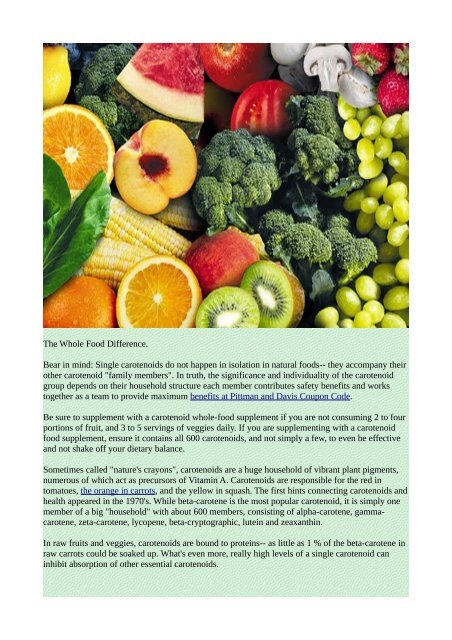The Carotenoid Gap: Carotenoid Health Perks Discovered
Often called "nature's crayons", carotenoids are a huge household of colorful plant pigments, numerous of which serve as precursors of Vitamin A. Carotenoids are liable for the red in tomatoes, the orange in carrots, and the yellow in squash. They are also present in green plants such as spinach, where they are obscured, or masked, by green chlorophyll.
Often called "nature's crayons", carotenoids are a huge household of colorful plant pigments, numerous of which serve as precursors of Vitamin A. Carotenoids are liable for the red in tomatoes, the orange in carrots, and the yellow in squash. They are also present in green plants such as spinach, where they are obscured, or masked, by green chlorophyll.
Create successful ePaper yourself
Turn your PDF publications into a flip-book with our unique Google optimized e-Paper software.
<strong>The</strong> Whole Food Difference.<br />
Bear in mind: Single carotenoids do not happen in isolation in natural foods-- they accompany their<br />
other carotenoid "family members". In truth, the significance and individuality of the carotenoid<br />
group depends on their household structure each member contributes safety benefits and works<br />
together as a team to provide maximum benefits at Pittman and Davis Coupon Code.<br />
Be sure to supplement with a carotenoid whole-food supplement if you are not consuming 2 to four<br />
portions of fruit, and 3 to 5 servings of veggies daily. If you are supplementing with a carotenoid<br />
food supplement, ensure it contains all 600 carotenoids, and not simply a few, to even be effective<br />
and not shake off your dietary balance.<br />
Sometimes called "nature's crayons", carotenoids are a huge household of vibrant plant pigments,<br />
numerous of which act as precursors of Vitamin A. <strong>Carotenoid</strong>s are responsible for the red in<br />
tomatoes, the orange in carrots, and the yellow in squash. <strong>The</strong> first hints connecting carotenoids and<br />
health appeared in the 1970's. While beta-carotene is the most popular carotenoid, it is simply one<br />
member of a big "household" with about 600 members, consisting of alpha-carotene, gammacarotene,<br />
zeta-carotene, lycopene, beta-cryptographic, lutein and zeaxanthin.<br />
In raw fruits and veggies, carotenoids are bound to proteins-- as little as 1 % of the beta-carotene in<br />
raw carrots could be soaked up. What's even more, really high levels of a single carotenoid can<br />
inhibit absorption of other essential carotenoids.


















